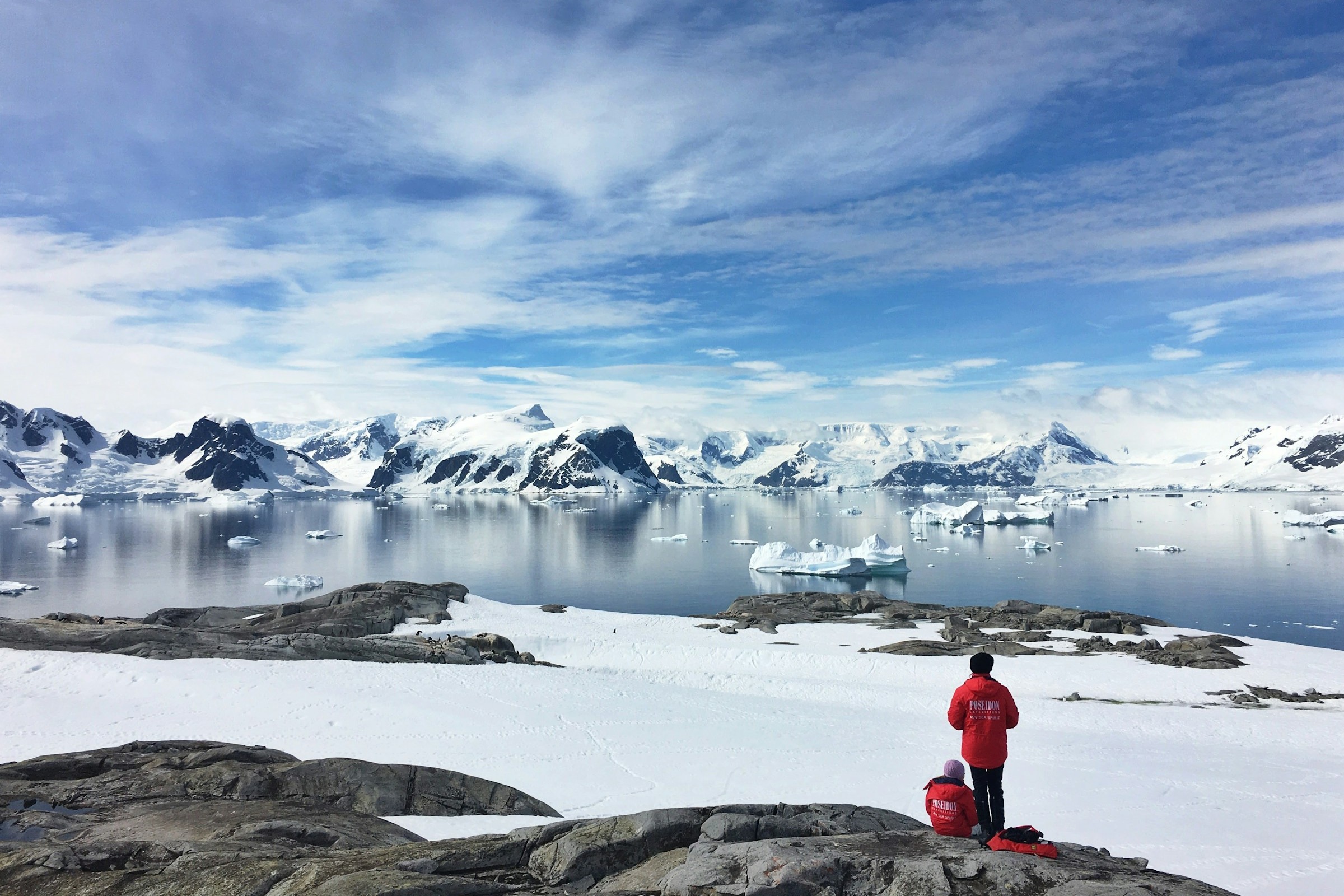
Fora’s Take
Embarking on an Antarctic cruise is an extraordinary adventure. Every aspect of the journey is crafted to enhance the experience of exploring one of the most untouched regions of our planet. Whether you prefer the close-up exploration of eco-friendly, intimate expedition ships or the comfort and luxury of larger vessels with panoramic views, there's a ship for every preference. This guide highlights some exceptional ships, each distinct in its features, to help you choose the ideal match for your journey through the southernmost waters of the globe.
The Fora Difference
Book with our team of advisors to unlock exclusive perks and discover hidden gems.
Killer perks
Free upgrades, spa credits and more—we got you
Personalized recs
Customized travel planning for your style
Insider knowledge
Expert advice from people who’ve actually been there
Where to stay in Antarctica
Unlock perks by contacting our team of advisors to book your trip.
Things to do in Antarctica

Embarking on an Antarctic cruise is a journey like no other, offering a rare opportunity to explore one of the most remote and mesmerizing landscapes on Earth. Whether you're drawn by the allure of pristine icy wilderness, the thrill of witnessing an array of wildlife in their natural habitat, or the desire to step into the shoes of legendary explorers, an Antarctic cruise promises an adventure filled with awe-inspiring sights and educational experiences.
The choice of vessel plays a pivotal role in shaping this once-in-a-lifetime expedition. From intimate, eco-friendly expedition ships that offer close encounters with the icy continent, to larger, luxurious vessels that provide scenic cruising with top-notch amenities, there's a ship to suit every taste and style of adventure. As you prepare to traverse the southernmost waters of the globe, let's explore a selection of ten remarkable ships, each with its unique offerings, to guide you in choosing the perfect companion for your Antarctic exploration.
Type of vessel:
Large Cruise Ships typically accommodate hundreds of passengers and offer a variety of amenities like multiple dining options, entertainment, and wellness facilities. They are a great choice for those who prefer comfort and stability but are less likely to offer land excursions due to their size.
Small Expedition Ships usually carry fewer than 200 passengers, providing a more personal and immersive experience. They are nimble enough to navigate closer to the shore and allow for landings in Zodiac boats. These ships often have a more informal atmosphere and focus heavily on the educational aspect of the journey.
Itinerary:
Classic Antarctic Peninsula cruises are the most popular and accessible. This region is renowned for its stunning scenery, including icebergs, glaciers, and abundant wildlife like seals, whales, and various bird species.
The Falkland Islands and South Georgia itineraries are longer and offer a broader experience. The Falklands are known for their unique birdlife, while South Georgia has rich historical significance and remarkable wildlife, including massive king penguin colonies.
Crossing the Antarctic Circle is for those seeking a more adventurous route. These cruises go further south, often encountering thicker sea ice and more extreme conditions, offering a sense of true exploration.
Duration:
Shorter cruises (10-12 days) typically focus on the Antarctic Peninsula and nearby islands. Longer voyages (up to 20+ days) might include the Falkland Islands, South Georgia, or crossing the Antarctic Circle, offering a more comprehensive exploration.
Activities:
Aside from the standard wildlife watching and photography, many cruises offer kayaking among icebergs, camping on the Antarctic continent, polar diving for the adventurous, and even mountaineering or snowshoeing. These activities often require advanced booking and come with additional costs.
Sustainability:
It's crucial to choose a cruise that follows strict environmental guidelines. Look for companies with a strong emphasis on minimizing their ecological footprint, educating passengers about conservation, and adhering to the regulations set by the Antarctic Treaty System.
Time of year:
The Antarctic cruising season runs from November to March, with each month offering a different experience. November and early December feature breeding season for many animals and pristine landscapes. The peak summer months of December and January are ideal for wildlife observation, with longer daylight hours. February and March are the best times for whale watching.
Budget and Comfort:
Costs vary widely based on the level of luxury, cabin type, and length of the voyage. Budget options might offer shared accommodations and basic amenities, while luxury cruises provide spacious suites, gourmet dining, and personalized services.
Lectures and expertise:
Educational components are a significant part of the Antarctic cruise experience. Look for cruises that offer onboard lectures and guided tours by experts in relevant fields. These can greatly enhance your understanding and appreciation of the region's unique ecosystem and history.
Departure points:
The majority of cruises to Antarctica depart from Ushuaia, the southernmost city in Argentina. Some longer expeditions may start from New Zealand or South Africa, offering different itineraries and perspectives of the Southern Ocean.
Reviews and reputation:
Researching the cruise line's reputation and reading reviews from past passengers can provide invaluable insights into the overall experience, quality of service, and reliability of the company.
Health and fitness requirements:
Antarctic cruises, especially those involving land excursions, require a reasonable level of fitness. Passengers should be able to climb in and out of Zodiac boats and walk on uneven terrain. Some activities like kayaking and camping might have higher physical demands.
Cruise options:
It's important to note that the following list of Antarctic cruise ships provided serves as an example to illustrate the diverse range of options available for such an expedition.
The actual availability of these ships can vary depending on a multitude of factors including the cruise season, operational changes, or updates in the offerings of different cruise lines.
Additionally, new ships are frequently introduced, and existing ones may undergo renovations or changes in their itineraries. Therefore, when planning your Antarctic journey, it's advisable to consult with your FORA advisor to ensure you have the latest information on the ships and their expeditions.
Please use our list to help you make the most informed decision for an unforgettable Antarctic experience tailored to your preferences and expectations but always consult with your advisor to confirm the availability for each season:
Celebrity Eclipse - Celebrity Cruises
The Celebrity Eclipse is a larger, luxury cruise ship known for its upscale amenities and comfort. With a capacity of over 2,800 passengers, it offers a variety of dining options, a large theater, a spa, and multiple pools. While large ships like the Eclipse cannot make landings in Antarctica, they offer scenic cruising with fantastic views of the Antarctic landscape from the comfort of the ship.MS Zaandam - Holland America Line
A mid-sized ship with a capacity of around 1,400 passengers, MS Zaandam is known for its elegant décor and impressive art collection. It provides a comfortable and refined experience with various dining options, music venues, and enrichment programs. The ship's size strikes a balance between the amenities of a larger vessel and the ability to navigate closer to Antarctic shores.Norwegian Star - Norwegian Cruise Line
This ship caters to those looking for a lively and casual atmosphere. With a capacity of over 2,300 passengers, Norwegian Star boasts an array of dining options, bars, entertainment shows, a spa, and sports facilities. Its Antarctic itineraries provide scenic cruising with educational talks and activities related to the region.Viking Orion - Viking Ocean Cruises
The Viking Orion is known for its modern Scandinavian design, offering a serene and upscale experience. With a capacity of just under 1,000 passengers, it provides an array of amenities including multiple dining venues, a spa, and a fitness center. The ship focuses on cultural enrichment and learning, with expert-led lectures and thoughtfully crafted itineraries.MS Roald Amundsen - Hurtigruten
This state-of-the-art hybrid vessel is one of the most environmentally friendly ships exploring Antarctica. The MS Roald Amundsen combines comfort with adventure, offering science centers, observation decks, infinity pools, and luxurious cabins. It's a great choice for those who want a sustainable and comfortable journey without compromising on the exploration aspect.National Geographic Explorer - Lindblad Expeditions
A top choice for educational and exploration-focused cruises, the National Geographic Explorer is equipped with tools for scientific research and offers a unique learning experience. Guests can attend lectures from experts in various fields and participate in citizen science programs. The ship is well-suited for those who want an immersive and educational journey.Le Lyrial - Ponant
Le Lyrial is known for its French elegance and luxury. It offers a more intimate experience with refined interior design, spacious suites, and personalized service. This ship is perfect for those seeking a blend of adventure and luxury, with excellent French cuisine, a wellness center, and a theater.Ocean Diamond - Quark Expeditions
A smaller, more intimate vessel, the Ocean Diamond is known for its excellent expeditionary capabilities and sustainability efforts, using biofuel to reduce its carbon footprint. It's well-suited for adventurous travelers who prefer a smaller group setting. The ship provides spacious cabins, a well-stocked library, and expert-led educational programs.Silver Explorer - Silversea Expeditions
For those seeking the pinnacle of luxury in the most remote place on earth, the Silver Explorer is an excellent choice. This vessel offers all-suite accommodations, gourmet dining, and personalized butler service. The ship is equipped with Zodiacs for close-up exploration and provides an ultra-luxury experience in the wild landscapes of Antarctica.
Places to eat & drink in Antarctica

The dining experience on Antarctic cruises can vary significantly depending on the type of vessel you choose, but one common factor is that most cruise lines strive to provide excellent culinary offerings to enhance the overall experience of the journey.
On luxury and larger cruise ships:
These ships typically offer a wide variety of dining options. You can expect gourmet meals, often prepared by skilled chefs, with menus that may include international cuisine and local specialties.
They often feature multiple dining venues, ranging from formal dining rooms to casual buffets and specialty restaurants. Some may even offer room service.
Luxury cruises might also offer culinary workshops or themed dining experiences.
On smaller expedition ships:
The dining experience is usually more intimate. While the options might be more limited than on larger ships, the quality of food is generally high.
Meals are often served in a communal dining area, which encourages interaction among passengers and crew.
The focus is usually on hearty, nourishing meals that are well-suited for the active nature of an expedition cruise.
Quality and variety:
Regardless of the ship size, there is typically an emphasis on providing high-quality meals, with fresh ingredients often stocked at the beginning of the journey. Menus are designed to cater to a variety of dietary needs, including vegetarian, vegan, gluten-free, and other dietary restrictions.
Special features:
Some cruises might have theme nights or feature dishes inspired by Antarctic explorations, adding a unique twist to the dining experience.
The availability of fresh produce might be limited due to the remote nature of the journey, but chefs on these cruises are adept at ensuring variety and creativity in their meal offerings.

The Modern Travel Agency
Fora

Reach out to a Fora Advisor.
Did you like this guide? Reach out to customize and book your own experience with a Fora Advisor. Or, to chat about travel in general.
You can normally expect a response from Fora within a business day or so. You’ll also be subscribed to our travel newsletter (you can unsubscribe at any time).
For more inspiration and insider recommendations, visit our Antarctica page.